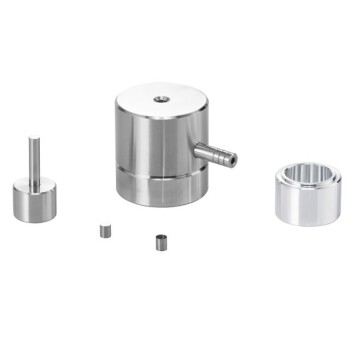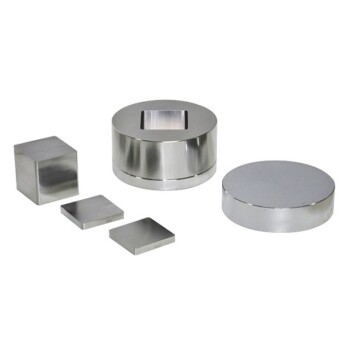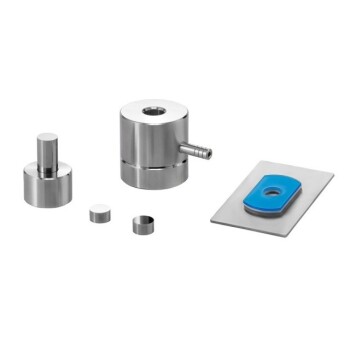At its core, pellets are used in XRF analysis to transform a loose, inconsistent powder into a solid, uniform sample with a perfectly flat surface. This preparation step is crucial for achieving the accurate, reproducible, and sensitive results required for quantitative analysis, but it does not completely eliminate underlying chemical interferences within the sample's structure.
Choosing to press a pellet for XRF is a calculated decision that balances analytical needs against practical constraints. It offers a significant leap in data quality over unprepared samples at a fraction of the cost and complexity of more advanced methods like fusion.
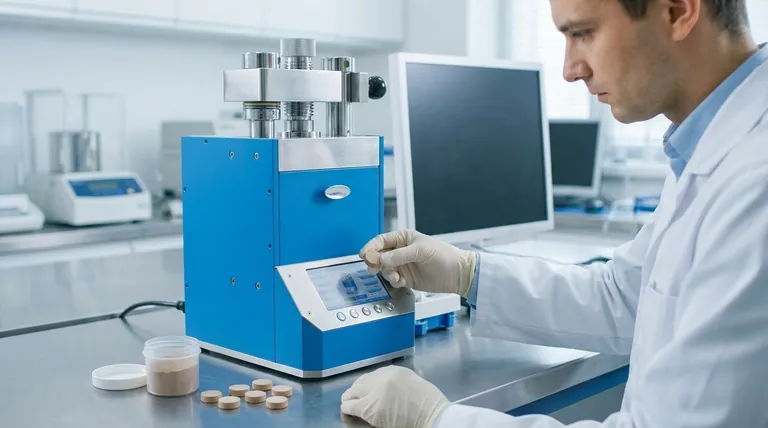
Why Raw Samples Are a Problem for XRF
The Challenge of Inconsistency
X-ray Fluorescence (XRF) analysis works by bombarding a sample with X-rays and measuring the secondary "fluorescent" X-rays that are emitted. The reliability of this measurement depends entirely on the sample presented to the instrument.
Raw, unprepared powders suffer from multiple issues, including uneven surfaces, void spaces between grains, and the segregation of heavier and lighter particles. This inconsistency means the X-ray beam will interact differently with the sample on every measurement, leading to poor precision and unreliable results.
The Impact of Particle Size
The size of the individual grains in a powder also has a major effect. Large or irregularly shaped particles can scatter the X-rays in unpredictable ways or create shadow effects, preventing a uniform signal from reaching the detector. This "particle size effect" can severely compromise the accuracy of the final analysis.
How Pressed Pellets Improve XRF Analysis
Creating Homogeneity and Density
The primary benefit of pressing a sample into a pellet is the creation of homogeneity. The immense pressure from a hydraulic or manual press compacts the powder into a solid disc with a uniform density.
This process eliminates void spaces and reduces the segregation of elements. The result is a sample that presents a consistent, representative surface to the X-ray beam, dramatically improving the reproducibility and accuracy of the measurement.
Increasing Signal Intensity
By compressing the material and removing air gaps, a pellet presents more atoms to the X-ray beam in the analysis area. This higher density leads to a stronger fluorescent signal for most elements.
This is especially critical when analyzing for trace elements in the parts-per-million (ppm) range, where a stronger signal can mean the difference between detecting an element and missing it entirely.
Ensuring "Infinite Thickness"
For a quantitative XRF analysis to be valid, the sample must be "infinitely thick" relative to the X-rays. This means the pellet must be thick enough to completely absorb the incoming X-ray beam.
If a sample is too thin, some X-rays may pass straight through it, and the resulting signal will not be representative of the bulk material's true composition. Pressing ensures the sample meets this critical thickness requirement.
Understanding the Key Trade-off: Mineralogical Effects
The Lingering Limitation of Pellets
The single greatest limitation of the pressed pellet method is the persistence of mineralogical or matrix effects. Pressing a sample changes its physical form, but it does not change its fundamental chemistry.
Elements bound in different mineral structures will absorb and fluoresce X-rays differently. For example, iron in an oxide (hematite) will behave differently than iron in a sulfide (pyrite), even if the total iron concentration is the same. Because pellets preserve these mineral structures, this effect can reduce the overall accuracy of the final quantification.
The Gold Standard: Fused Beads
To eliminate mineralogical effects completely, analysts turn to a method called fusion. This involves dissolving the sample in a molten lithium borate flux at high temperatures, which destroys all original crystal structures. The molten mixture is then cast into a perfectly homogeneous glass disc.
Fused beads offer superior accuracy because they remove all matrix effects. However, this comes at a significantly higher cost in terms of equipment, energy consumption, and sample preparation time.
The Pragmatic Choice
Pressed pellets represent the ideal middle ground. They are fast, cost-effective, and deliver the high-quality, consistent results needed for a vast range of applications, particularly in industrial quality control. They provide a massive improvement over raw powders without the high overhead of fusion.
Making the Right Choice for Your Analysis
Choosing your sample preparation method depends entirely on your analytical goal.
- If your primary focus is speed and cost for routine process control: Pressed pellets are the ideal choice, offering excellent precision and a major accuracy boost over unprepared samples.
- If your primary focus is the highest possible accuracy for certification or research: Fused beads are necessary to eliminate mineralogical effects and achieve the most reliable quantitative results.
- If your primary focus is maximizing sensitivity for trace elements: Pressed pellets are highly effective, as the increased sample density significantly enhances signal intensity compared to loose powders.
By understanding this balance between preparation effort and analytical accuracy, you can confidently select the right XRF method to achieve your objective.
Summary Table:
| Aspect | Pressed Pellets | Fused Beads |
|---|---|---|
| Preparation Time | Fast | Slow |
| Cost | Low | High |
| Homogeneity | High | Very High |
| Mineralogical Effects | Present | Eliminated |
| Accuracy | Good for routine | Best for high accuracy |
| Trace Element Sensitivity | High | Moderate |
Ready to enhance your XRF analysis with reliable sample preparation? KINTEK specializes in lab press machines, including automatic lab presses, isostatic presses, and heated lab presses, designed to meet the needs of laboratories seeking precise, efficient, and cost-effective solutions. Our equipment helps you achieve superior homogeneity and sensitivity in your samples, saving time and improving data quality. Contact us today to discuss how our products can support your analytical goals and boost your lab's performance!
Visual Guide
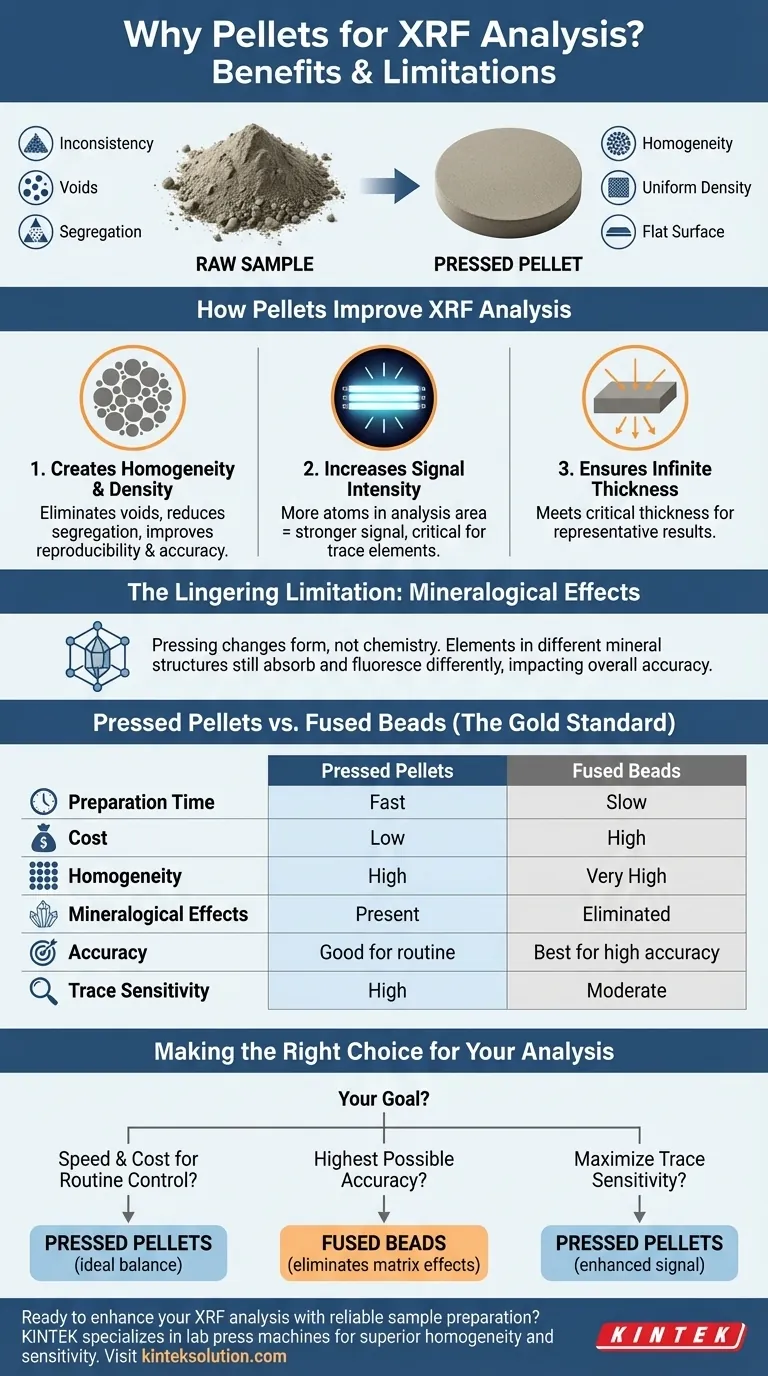
Related Products
- Automatic Laboratory Hydraulic Press for XRF and KBR Pellet Pressing
- Laboratory Hydraulic Press 2T Lab Pellet Press for KBR FTIR
- Laboratory Hydraulic Press Lab Pellet Press Button Battery Press
- Laboratory Hydraulic Split Electric Lab Pellet Press
- Automatic Laboratory Hydraulic Press Lab Pellet Press Machine
People Also Ask
- What are the advantages of using hand presses in laboratories? Boost Precision and Efficiency in Your Lab
- How are hydraulic presses used in spectroscopy and compositional determination? Enhance Accuracy in FTIR and XRF Analysis
- How are hydraulic presses used in laboratory sample preparation? Ensure Accurate Analysis with Homogeneous Samples
- What is the purpose of creating pellets for XRF spectroscopy using a hydraulic press? Ensure Accurate and Repeatable Elemental Analysis
- Why is a hydraulic press important for FTIR spectroscopy? Ensure Accurate Sample Analysis with KBr Pellets







